How the New York Rangers bottom six stacks up


The top offensive players on the New York Rangers have gotten most of the headlines this season, but their bottom six players are vital to their hope for success. How do the Blueshirts compare to their playoff rivals?
Entering the last stretch of this season, the New York Rangers’ most recent bottom six players consisted of players who were mostly new arrivals. Although the Rangers are front-loaded with a lot of talent, the club must ensure all of their lines can contribute to team success as they transition into an era of becoming a postseason contender once again. As we take a look at the other teams trying to crack the playoffs, we will compare the caliber of two teams’ bottom six.
While hockey fans acknowledge the fact that the bottom six forwards are not the ones who lead the team, there is value in looking more closely at this part of the roster, especially during this time. Since the formula for winning a Stanley Cup requires a team to have adequate depth in their scoring, the New York Rangers should ensure that the pieces they have can be upgraded or developed into a group of steady contributors.
Lately, the Rangers’ bottom six were a mix of Filip Chytil, Brett Howden, Kaapo Kakko, Brendan Lemieux, Greg McKegg, and Julien Gauthier. The good news here is that these lines consist of young players. While there is room for improvement, this group gives the organization a decent foundation.
Two of the other NHL teams also in the midst of a playoff push similar to the Rangers include the New York Islanders and the Nashville Predators. We will take a look at their bottom six and see how these teams stack up in terms of depth.
Over the course of the past few seasons, it has become apparent the Rangers need more depth in their roster. They will need a higher quality core of bottom players to be a threat in the league, especially the grueling Metropolitan division. Because the club is extremely young, it will be interesting to see how the organization plans to achieve this– will they trade or trust in development?
Additionally, statistics cannot provide a comprehensive evaluation into the whole effectiveness of a team’s line. Each player or each line can serve a different purpose— to grind down the opposition, out skate the other team or keep veterans together. Again, the function of the bottom six in totality is to provide depth, and since this team is run by a coach such as David Quinn who holds every single player accountable regardless, the team will need to come as close to perfect as they can with all four lines.
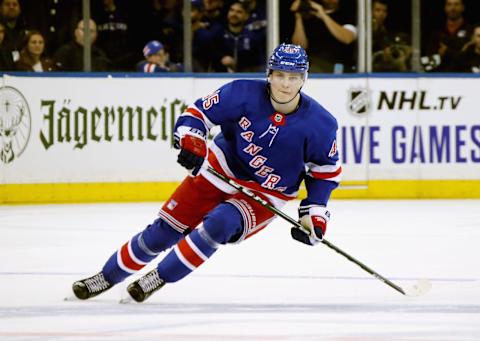
The bottom two left wings
The two left wings for the Rangers’ bottom two lines have been frequented by Chytil and Lemieux. Although as Chytil develops and grows with the team he will most likely move up lines into his natural center position given his flair for offense. There is a lot of hope for Chytil and his future with Broadway seems very bright.
The young Chytil has been linemates most usually with Howden and Kakko on the third line. Who centers the line, between Chytil or Howden depends on the circumstances. There appears to be budding chemistry between Kakko and Chytil, which could be the start of a great foundation for the future.
For his line, Lemieux provides grit and can be a pest for opposing players. He tends to be on the ice with McKegg and Gauthier. This last line offers a bit of everything– toughness, speed, and size.
Two days before the season was officially paused, Chytil was injured during a game against the Dallas Stars. He was then replaced by Steven Fogarty for the Colorado game the next day, who did not collect any points that game.
The 20-year-old Czech player was nearing the cooling off period after impressing fans since a short stint with the Rangers’ minor league affiliate this season. Chytil was able to collect 14 goals and nine points in 60 games with the Blueshirts and continues to fuel hope for his success.
Lemieux, who joined the Rangers last season coming from the Winnipeg Jets, registered six goals and 12 assists in 59 games. For the two centers, that is a total of 20 goals and 21 assists for a total of 41 points between Chytil and Lemieux. As previously mentioned, these are both young players and have time to become more offensive producers.
The bottom two centers
Howden and McKegg take the role as the bottom two centers. Howden, only 22 years old has time to find rhythm and become a steady point getter, but for now he needs to be making the most of all the opportunities he is getting. Howden netted nine goals and picked up 10 assists in his 70 games this season. Again, he often played the wing with Chytil, but the Rangers do see his future at center.
The addition of McKegg announced on the first day of free agency in 2019 caught some off guard. Regardless of signing all star Artemi Panarin and trading Jimmy Vesey that same day, the news of McKegg’s arrival still would have been mundane for a bottom six guy.
McKegg does, however, bring speed to the table, which is a valuable quality to have dispersed. The 27-year-old recorded five goals and four assists in 53 games this season. This shows he needs to take better advantage of his speed and needs to start the rush or set up other teammates.
Totaled with fellow center, Howden, that is 14 goals and 14 assists for a collective 28 points put up by both centers.
The bottom two right wings
Our second overall draft pick last summer, Kakko and recent addition Gauthier claim the bottom right wing roles. Both players are extremely young, Kakko at 19 and Gauthier at 22 and both in the midst of their first years in the big leagues. Gauthier skated in five games with the Carolina Hurricanes before joining the Blueshirts during the season.
On the season, Kakko has 10 goals and 13 assists in 66 games played. Although the Finnish-born winger did not perform as highly as many had anticipated his first season, there is nothing but time for Kakko to develop.
On the other line, Gauthier, who is still waiting for his first NHL goal ,had picked up three assists in his 17 games with Carolina and the Rangers. These two right wingers for the team are promising. While Kakko is projected miles ahead of Gauthier, they both provide big-bodied hockey which plays a part in having four fully functioning lines.
Together the two right wings have tallied 10 goals and 16 assists to amount to 26 points this year.
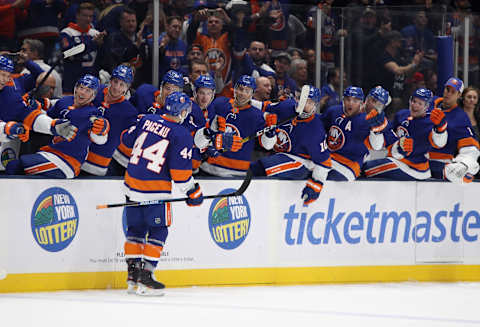
Jean-Gabriel Pageau #44 of the New York. (Photo by Bruce Bennett/Getty Images)
New York Islanders
Although any given team sees line shuffles game-to-game and during a matchup, Head coach of New York Islanders, Barry Trotz, is notorious for mixing up the club’s lines. Due to injuries and coaching decisions, there have been copious line and position swaps over the course of this season and some changes trying to generate five-on-five offense.
This Metro rival is a team known for their collection of protean veterans and two-way players and thus, are more competent defensively than offensively. Only one point separates the Islanders (80) from the Rangers (79) in the standings and there is little room for error in the East Conference.
The bottom two left wings
Still looking most recently at the bottom six, the New York Islanders utilized veterans Andrew Ladd and Matt Martin as their bottom two lines. Ladd most often frequented the third line with center Brock Nelson and winger Leo Komarov.
Both wingers are versatile, two-way forwards and have considerable playoff experience. Ladd, who has two Stanley Cups under his belt, has been riddled with injury in this phase of his career and only appeared in four games this season with the Islanders. Ladd has registered one goal and zero assists in those four games.
Although Martin has been the steady fourth line left winger alongside Derick Brassard and Cal Clutterbuck, prior to Ladd’s return we recently saw Michael Dal Colle in his place for the most part. The bulky 23-year-old has four goals and six assists in 53 games played this season.
Martin, known for his toughness, produced five goals and assisted on three goals in 55 games this year. Together, Dal Colle and Martin have produced nine goals and nine assists for a total of 18 points.
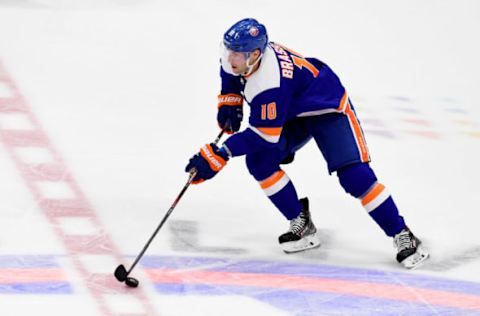
The bottom two centers
Former Ranger Derick Brassard and Brock Nelson tended to be delegated the roles of the bottom two centers. Although the players have a veteran status in common, they have a lot more contrasts between them. Brassard was a new addition this season, meanwhile Nelson has spent his career on Long Islander since being drafted in round one 10 years ago.
Brassard, who can count the Islanders as his seventh team, was once a fan favorite in Madison Square Garden, but has struggled to steadily maintain production since being flipped to Ottawa for Mika Zibanejad. The Islanders saw potential in the 32-year-old and signed him for one year.
In 66 games donning an Isles jersey, he has tallied 10 goals and 22 assists. This resurgence is the best he has looked since his last year in Ottawa during the 2017-2018 season. Being one of the smaller bottom six players, Brassard focuses on offense which helps him and Nelson provide a splash of depth offense for the organization.
Nelson, another large-bodied player, has 26 goals and 28 assists with the Isles in 68 games on the year. He is clearly a player who is not afraid to take shots and is another player who provides offensive and defensive capabilities. Nelson is a great center to build a line around and has seen a lot of movement up and down amongst lines.
Impressively, the two centers registered 36 goals and 50 assists combined to collect 86 points.
The bottom two right wings
Komarov and Clutterbuck saw a lot of the right wing in the bottom two lines, but have also been shuffled a bit as well. Maintaining the trend of a veteran bottom core, Komarov, who joined the club last season, offers a gritty style of play but can consistently put up numbers as well.
In 48 games, Komarov has netted the puck four times and has picked up 10 assists. While he focuses more on the physicality of the game, he is able to produce some goal helpers and shows he has dimension to his game.
Although fellow winger Clutterbuck does not compensate offensively for the pair, it is clear these two maintain physicality among the lines. He has three goals and four assists in 37 games.
Komarov and Clutterbuck have seven goals and 14 assists for a summation of 21 points.
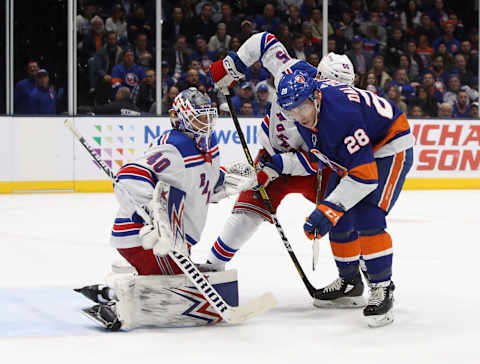
How they stack up
The bottom six for the Islanders are older in age, on average, whereas the Rangers are front-loaded with veteran talent in their top six. This dynamic brings into question the need for the Rangers’ to strengthen their ability to wear teams down by using their bottom six.
Although these clubs are categorized as different types of teams, a Stanley Cup contender will need to have the right variety of all aspects to earn the title. For a fellow divisional team who has a shot at making the playoffs a consecutive year, the Rangers could look at the Isles to get some perspective as they compete in this stacked division.
The Islanders’ wingers clearly serve a more defensive purpose than the Rangers. In fact, the Rangers’ left wingers are the top producing position of the bottom six combined, in contrast the bottom two centers produce the most for Long Island.
The bottom core formula for Islanders is characterized by older physical wingers and offensive centers. This is a strategy that allows for depth and tiring opposition. Although the rivals are only separated by one point, the Islanders were able to set a franchise record with a 16-game point streak this season, so this equation could serve as guidance for the future Rangers.
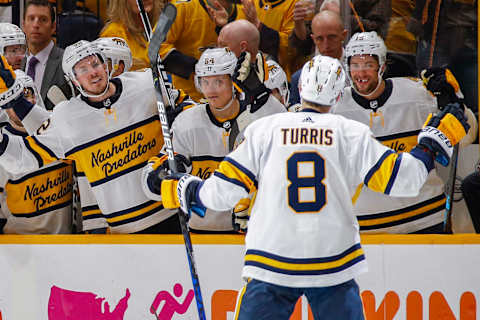
Kyle Turris #8 of the Nashville Predators. (Photo by Frederick Breedon/Getty Images)
Nashville Predators
Nashville’s team has been a perennial Cup contender and an all-around tough team to face. They sit in the Central Division with 78 points with few points dividing the other organizations.
Another group of veterans that also can find themselves on any line, newly hired head coach John Hynes does not view any player untouchable despite their salary. Hynes believes ice time is based on merit and skill and therefore, his lines can flip drastically from night to night.
The bottom two left wings
Craig Smith and Colin Blackwell tend to stick to the bottom lines while Calle Jarnkrok has made an appearance recently.
30-year-old Smith has tucked 18 goals and registered 13 assists in 69 games for Nashville thus far. A career-long Predator player who has led his team in scoring in the past, the veteran has plenty of postseason experience and is a solid member of his team logging points consistently and providing many assets to the club.
Blackwell, who is by nature a center, has only recently gotten a full taste of the big league. He recorded his first NHL point in December 2019 and his first goal in January. Since then, the 27-year-old has three goals and seven points in 27 games. He is a smaller player and can see anywhere from 10 to 15 minutes of ice time a night.
Jarnkrok, another career-long Predator, has been another reliable contributor for his team after his first full season. He has also been a propeller for the Predators in the postseason, and another valuable tool for Nashville. In 64 games, he has scored 15 times and picked up 19 assists.
This group of forwards for Nashville is a highly offensive core, which shouldn’t come as a surprise since they are not players continually stuck in the bottom necessarily. Smith and Jarnkrok have a combined total of 65 points, broken down by 33 goals and 32 assists.
The bottom two centers
Nick Bonino and Kyle Turris both joined Nashville for the 2017-18 season and have been picking up points ever since.
Bonino, who played a role in Pittsburgh’s back-to-back Cup wins in 2016 and 2017, contributed with his two-way style and even finished one postseason with a team-best record for assists. The 32-year-old experienced forward has been keeping up with his career numbers to help his current team.
During his 67 games this year, Bonino has 18 goals and 17 assists, which matches his season total from the previous season.
Turris, who was accustomed to a top six role for Ottawa before the Predators, is yet again another steady producer for the team. With nine goals and 22 assists in 62 games the 30-year old has been more of a regular season presence for Nashville. In 19 postseason games between 2018 and 2019, Turris had five points, but was once a key player in his former team’s playoff run.
Bonino and Turris have a combined 66 points, in which 27 are goals and 39 are helpers.
The bottom two right wings
Rocco Grimaldi and Yakov Trenin carried the role as bottom six forwards, but most recently on the right wing. Although both moved around, the pair has exhibited versatility like many other players for this team. Viktor Arvidsson has also seen a decent amount of the third and fourth line since February and in different positions.
Grimaldi, who stands at 5’6, has doubled his season goal total and almost tripled his number of assists from his first season in Nashville. In 66 games, he has 10 goals and 21 assists. Grimaldi is a high-energy player who plays hard along the boards which is an integral quality of a skillful winger.
The young Trenin, who has appeared in 21 games this season, has two goals and four assists. He is in his first year in the NHL
Arvidsson has 15 goals and 13 helpers in 57 games on the season, and can be used flexibly on both wings. Although he has a smaller stature than Trenin, he is yet another lifelong Predator and a major force in pushing the team into the postseason in the 2016-17 season.
Combined, Grimaldi and Trenin have 12 goals and 25 assists to equal 37 points.
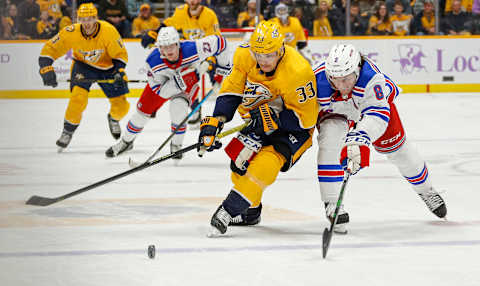
How they stack up
The Predators can be a tiring team to play again, but their bottom six is not compromised of big-bodied players. As we’ve seen with the Islanders, this is a generally veteran dominant group of players.
The Predators were in the midst of a winning streak when the season was halted. The club was becoming acquainted with their new coach and enjoyed more reliable goaltending all at once, but were running out of time for a secured spot. Still, the team was experiencing success.
Although another team different from the Rangers, the Predators would not be another bad team to model after. The majority of their bottom six rotation can play both wings and even the centerman position if needed. We see less experimentation with this on the Rangers, but still some.
It is clear this team is full of chemistry and experience by the points they can put up despite being moved around. The tactic Hynes deploys by earning the line is something we do not see from Quinn as much.
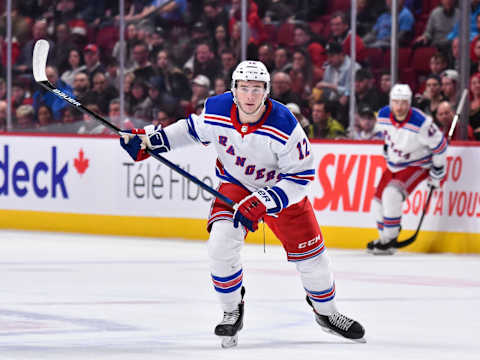
A final thought
Although the Islanders’ and Predators’ numbers differ vastly from that of the Rangers’ typical bottom six, the good news is that the Blueshirts could have the pieces to match these teams. They also have the time to grow together into a veteran core of career Rangers, similar to these two other teams.
As suspected, the numbers from the Rangers’ bottom six fall flat of the other teams pushing for playoffs, keeping in mind their youth. The Rangers bottom six put up 95 points collectively, while the Islanders recorded 125 and the Predators have generated 168 points from their bottom two lines.
More from Blue Line Station
- Blake Wheeler’s Broadway Calling: Why He Chose the Rangers
- Rangers’ Playoff Redemption Recipe: Grit and Fresh Hopes
- Rangers’ Roster Chatter: Who’s Making the Cut and Who’s in the Penalty Box?
- Jacque Plante Trade Tree Between the Rangers and Canadiens
- These Rangers must learn Peter Laviolette’s ropes before they can fly
Again, statistics should not be solely relied upon as the bottom six players provide a wide variety of purposes, but while the Rangers are in this unique situation they should be planning ahead. While it is an interesting perspective to view the numbers, they should be used as a reference point and not a nonnegotiable model.
Simply put, perhaps the Rangers could be looking to obtain higher quality pieces, or pieces that can be better rotated for various situations. It’s not that our players cannot be moved around in terms of position, but perhaps we could explore that as on option.
Equally important to note is the decisions of the coach to shuffle the lines. The lines for the Rangers are not shuffled nearly as much as Trotz or Hynes would typically do. Decisions to mix the lines can be determined upon generating offense in certain situations, trying to stifle a drought, or rewarding players. Each organization has a different system to their lineup decision.
For a group of bottom six, perhaps the organization should be demanding more from the league acquainted players, or look elsewhere.
More. Proposed playoff format doesn't help the Blueshirts. light